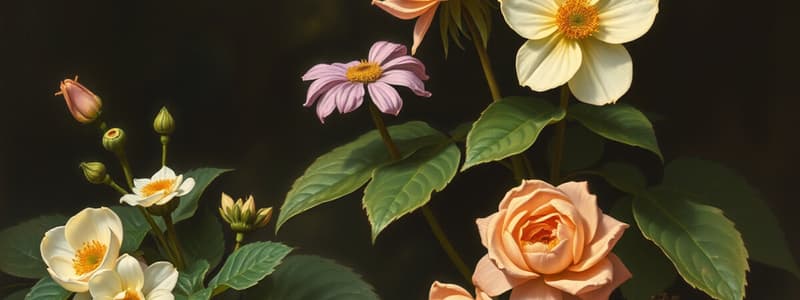Podcast
Questions and Answers
Which of the plant groups needs both land and water to complete their life cycle?
Which of the plant groups needs both land and water to complete their life cycle?
- Thallophyta
- Tracheophyta
- Bryophyta (correct)
- Pteridophyta (correct)
A plant that has seeds but no flowers and fruits?
A plant that has seeds but no flowers and fruits?
- Mosses
- Pteridophytes
- Bryophytes
- Gymnosperms (correct)
Most primitive vascular plants?
Most primitive vascular plants?
- Cycads
- Kelps
- Mosses
- Ferns (correct)
Plants that possess spores and embryo but lack vascular tissues and seeds?
Plants that possess spores and embryo but lack vascular tissues and seeds?
Which one is not an exception in angiosperms?
Which one is not an exception in angiosperms?
Pteridophytes differ from mosses in?
Pteridophytes differ from mosses in?
Angiosperms are the dominant flora because of?
Angiosperms are the dominant flora because of?
Plants reproducing by spores are grouped under?
Plants reproducing by spores are grouped under?
Plants having vascular tissue without seeds?
Plants having vascular tissue without seeds?
The plant group that possesses the largest ovule, largest gametes, and largest tree?
The plant group that possesses the largest ovule, largest gametes, and largest tree?
Zygotic meiosis is the characteristic of?
Zygotic meiosis is the characteristic of?
Pick the mismatched pair?
Pick the mismatched pair?
A colonial alga is?
A colonial alga is?
Double fertilization is the characteristic of?
Double fertilization is the characteristic of?
Conifers can tolerate extreme environments because of?
Conifers can tolerate extreme environments because of?
First plants to inhabit the land?
First plants to inhabit the land?
Agar is commercially obtained from?
Agar is commercially obtained from?
Which one differs from Spirogyra based on its nucleus?
Which one differs from Spirogyra based on its nucleus?
The cell wall of Spirogyra contains?
The cell wall of Spirogyra contains?
Which of the following completely lacks a cell wall?
Which of the following completely lacks a cell wall?
Prothallus gives rise to sporophyte without fertilization. This is known as?
Prothallus gives rise to sporophyte without fertilization. This is known as?
Chromatophores participate in?
Chromatophores participate in?
Which one is responsible for the formation of peat?
Which one is responsible for the formation of peat?
Isogamous condition with non-flagellated gametes is found in?
Isogamous condition with non-flagellated gametes is found in?
The exine of pollen grain comprises?
The exine of pollen grain comprises?
Meiosis occurs in?
Meiosis occurs in?
An evolutionary important character of Selaginella is?
An evolutionary important character of Selaginella is?
Which is the common characteristic of multicellular fungi, filamentous algae, and protonema of mosses?
Which is the common characteristic of multicellular fungi, filamentous algae, and protonema of mosses?
Vascular bundles are not found in?
Vascular bundles are not found in?
The transport of male gametes in bryophytes and pteridophytes occurs through?
The transport of male gametes in bryophytes and pteridophytes occurs through?
Flashcards are hidden until you start studying
Study Notes
Plant Life Cycles
- Pteridophyta and Bryophyta need both land and water for their life cycles.
- Bryophyta lacks vascular tissues; they possess spores and embryos.
Seed and Flower Characteristics
- Gymnosperms have seeds but do not produce flowers or fruits.
- Angiosperms display double fertilization, which distinguishes them from other plant groups.
Vascular Plant Categories
- Most primitive vascular plants are represented by ferns (Pteridophyta).
- Plants with vascular tissues but no seeds include Pteridophytes.
Angiosperm Features
- Angiosperms dominate due to adaptability, self-pollination, and high seed production.
- Exceptions in angiosperms include traits like double fertilization and presence of vessels.
Reproductive Structures
- Pteridophytes feature a dominant sporophyte phase, contrasting with the dependent gametophyte phase in mosses.
- Cryptogams are the group of plants that reproduce via spores.
Unique Traits of Plant Groups
- Gymnosperms are characterized by large ovules and trees.
- Double fertilization is unique to angiosperms.
Environmental Adaptations
- Conifers are well adapted to extreme environments due to features like thick cuticles and superficial stomata.
Historical Context
- Bryophytes were the first plants to colonize land.
Algae Types
- Agar is obtained from red algae, commonly used in laboratories.
- Colonial algae includes Volvox, which differs from other algae types.
Reproductive Methods
- Apogamy describes the ability of prothallus to give rise to sporophytes without fertilization.
- Isogamous conditions with non-flagellated gametes occur in Spirogyra.
Cell Structure
- The cell wall of Spirogyra is made of cellulose.
- Pollen grains feature an exine composed of sporopollenin.
Spore Formation and Life Cycle
- Meiosis occurs in structures called meiocytes.
- The important evolutionary characteristic of Selaginella includes its heterosporous nature.
Nutritional and Life Cycle Commonalities
- Multicellular fungi, filamentous algae, and moss protonema exhibit fragmentation for multiplication.
Transport Mechanisms
- In bryophytes and pteridophytes, male gametes are transported by water.
Vascular Bundle Presence
- Vascular bundles are absent in Bryophytes, while present in Gymnosperms, Pteridophytes, and Angiosperms.
Studying That Suits You
Use AI to generate personalized quizzes and flashcards to suit your learning preferences.




